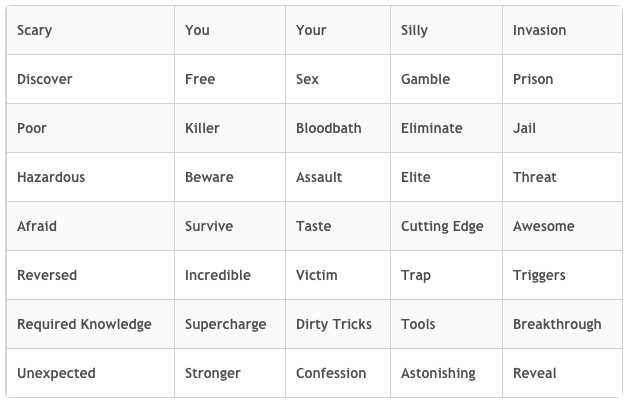
Have are our 10 tips to writing SMS copy for successful campaigns.
1. Make your message short & to the point
By the very nature of an SMS, you limited to 160 characters per message. As well as this you have to contest with the short attention spans of your audience. Tip number one is to get to the point quickly and get the point across well, try to do it within the first few words. Use gripping opening words like “SALE”, or “FREE”. Address the reader’s “what’s in it for me?” factor straight away to persuade them to not only read the rest of the message, but to also take up the offer.
2. Highlight important words with CAPITAL LETTERS
SMS is ubiquitous due to its simplicity, however that does mean it has a few restrictions. One such restriction is the ability to style and format words, as such there is no way to bold or emphasise important words other than putting them in CAPITALS. Therefore, if you want certain words to jump out, such as SALE or FREE DELIVERY, it is actually good practice to use capitals to do so. But use them sparingly or else the words will no longer stand out but you’ll look like you’re shouting.
3. Personalise messages
With a good SMS provider, you’ll be able to personalise messages. This can help with engaging your reader. By using a person’s name when addressing them, you are psychologically breaking down the impersonal barrier, making them subconsciously trust you. Even if this trust is only fractional, it can distinguish you from your competitors.
side note: be wary of your character count. If you’re not careful you can insert long names that take a few of your messages over that 160 limit and cost a bit more money.
4. Use strong call-to-action
Recipients of your message are looking for clues as to what they are supposed to do next. A strong and clear call to action can be the key to getting a sale instead of your message simply being ignored. The best place for the call to action is at the end of the message, as a final instruction to the recipient. Here are a few examples of good call to actions:
- Act Fast
- Sign Up Now
- You Can’t Go Wrong
- You Don’t Want To Miss Out
- Buy Now
- Don’t Miss Out
- Incredible Offer
- Last Chance
- Limited Time Offer
- Lowest Price
- Longtime Favorite
- Opportunity Knocks
5. Add urgency
With anything in life, people are susceptible to putting things off until absolutely necessary. Making a deal or message seem urgent is a great way to get customers to act fast. Saying a deal ends in two days gives them a real need to plan how they can take advantage as they read the message. Their thought process might go something like this “I can’t make it today, so I’ll have to go tomorrow” – the message is planted and the plan has already been made, as opposed to a deal lasting several weeks, they might think “Well, I’ll probably head down later in the month”, by which time they have forgotten and it’s no priority in their mind.
6. Use power words
Commit to including some power words to really engage your audience. Make sure you use these power words carefully and appropriately and you’ll be able to get in touch with your recipients emotions. Here are the top 40 power words from copy writing expert David Aston:

source: incomediary.com
7. Write in short sentences
Short sentences are more engaging and more easily recalled. By writing long and complex sentences you often lose peoples’ interest quickly. Stick to writing at 5th grader level and you’ll maintain the attention of your reader. This is especially important when you are selling something. Keeping the points short and succinct help them to sink into you readers mine, and stay there.
8. DO NOT use text-speak
If a business sends an SMS to their customers using text speak, for example saying ‘l8r’ instead of ‘later’, or ‘w8’ in replacement for ‘wait’, or even ‘u’ instead of ‘you’, it completely devalues the brand and comes across as spammy. You’ll likely find your message deleted instantly and lose a lot of respect for your brand. You’re a business not a 12-year-old.
9. Watch out for special characters
With SMS messages there are technical specifications as to which characters you can use. Many carriers only support unicode, so using special apostrophes and quotation marks, the ones that look like 6s and 9s, may not work, and will display on the recipients phone as either something quite random or as a space. Some SMS providers will try to minimise the damage by replacing unknown characters with a space.
With this guideline, you should now be able to focus on creating great marketing copy for your SMS campaigns. The better the message, the better the results. A final thought to leave you with is to make sure you test, revise and test again. You will only be able to get to the perfect SMS marketing copy by finding out what drives your particular audience to the required action. Measure the results of each campaign until you have something that works, and then test some more to try and improve upon that. SMS can be really valuable, and the copy is not something you should rush. Remember, 98% of the people you send this to are going to read it.
10. Include an opt-out option
Finally, with marketing messages of any kind, especially with the new anti-spam laws, has to have an opt-out option. SMS is no different. It will use up a number of credits, however it will potentially save you thousands in fines. Good ways to handle this is to send the message from a virtual mobile number – a number that can receive SMS back to – and say “Reply STOP to opt-out” or you can send from your company name and include the virtual mobile number within the message, for example “Opt-out send STOP to 0411111111”.
It’s also worth mentioning that by law, it has to be clear whom the message has come from. So this also has to be taken into account. Do you use a virtual mobile number and include your brand in the message, or do you have it come from your brand name and include the virtual mobile number within the message.
If you think you can master writing copy for SMS, and haven’t yet given it a try, sign up for a free trial with Esendex and test your skills.
